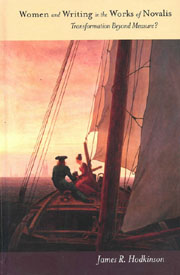Book contents
- Frontmatter
- Contents
- Acknowledgments
- Abbreviations of Major Primary Works Cited
- Typological Conventions in Novalis: Schriften
- Introduction
- 1 Writing in Context: Romanticism, Gender, and the Case of Novalis
- 2 Writing about Women, 1795–99
- 3 Esteem and the Epistolary: Hardenberg and Women of Letters
- 4 Music and the Manifold of Voices: The Subject and the Theory of Polyphony, 1797–99
- 5 From Music to Metamorphosis: Women's Role and Writing in Heinrich von Ofterdingen, 1798–1801
- 6 “Freyes Fabelthum”: The Poetic Construction of Gender in Hardenberg's Religious Writing
- Conclusion: Progression, Reaction, and Tension in Hardenberg's Gender Writing
- Works Consulted
- Index
6 - “Freyes Fabelthum”: The Poetic Construction of Gender in Hardenberg's Religious Writing
Published online by Cambridge University Press: 05 February 2013
- Frontmatter
- Contents
- Acknowledgments
- Abbreviations of Major Primary Works Cited
- Typological Conventions in Novalis: Schriften
- Introduction
- 1 Writing in Context: Romanticism, Gender, and the Case of Novalis
- 2 Writing about Women, 1795–99
- 3 Esteem and the Epistolary: Hardenberg and Women of Letters
- 4 Music and the Manifold of Voices: The Subject and the Theory of Polyphony, 1797–99
- 5 From Music to Metamorphosis: Women's Role and Writing in Heinrich von Ofterdingen, 1798–1801
- 6 “Freyes Fabelthum”: The Poetic Construction of Gender in Hardenberg's Religious Writing
- Conclusion: Progression, Reaction, and Tension in Hardenberg's Gender Writing
- Works Consulted
- Index
Summary
HARDENBERG NEVER REALLY ESCAPED the presence of death after 1797. Sophie's death was followed in April of the same year by that of his brother Erasmus. In 1798, Jeannette Danscour died, and when Hardenberg took his convalescence in Teplitz, he did so most likely because he had himself been diagnosed with tuberculosis — a fatal disease in the eighteenth century. Then there was his desire to die. During his mourning for Sophie, he often expressed in speech or writing the idea that he no longer belonged in the world of the living, that his destiny lay “elsewhere” and simply that, while he was still alive, he would rather be dead. Even in early 1799, after expounding a whirl of plans for his future life and career, feeling loved, as he put it, as he never had been before, he felt nevertheless moved to write: “Ein sehr interessantes Leben scheint auf mich zu warten — indeß aufrichtig wär ich doch lieber todt” (N IV, 273:130). In late 1799 and early 1800 Hardenberg gave one final literary performance of Sophie's death and did so in the only strictly poetic work that he successfully published in his lifetime: the Hymnen an die Nacht. This has added fuel to the fire of the myth of Novalis; a myth that saw his whole literary output as determined by Sophie's death.
- Type
- Chapter
- Information
- Women and Writing in the Works of NovalisTransformation beyond Measure?, pp. 244 - 252Publisher: Boydell & BrewerPrint publication year: 2007



